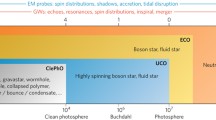Abstract
By analyzing a gedanken experiment designed to measure the distance l between two spatially separated points, we find that this distance cannot be measured with uncertainty less than (ll2 P)1/3, considerably larger than the Planck scale lP (or the string scale in string theories), the conventional-wisdom uncertainty in distance measurements. This limitation to space-time measurements is interpreted as resulting from quantum fluctuations of space-time itself. Thus, at very short distance scales, space-time is “foamy.” This intrinsic foaminess of space-time provides another source of noise in the interferometers. The LIGO/VIRGO and LISA generations of gravity-wave interferometers, through future refinements, are expected to reach displacement noise levels low enough to test our proposed degree of foaminess in the structure of space-time.
Similar content being viewed by others
REFERENCES
S. Weinberg, Rev. Mod. Phys. 61, 1 (1989); Y. J. Ng, Int. J. Mod. Phys. D 1, 145 (1992); for a possible solution, see Y. J. Ng and H. van Dam, Phys. Rev. Lett. 65, 1972 (1990); hep-th/9911102.
S. W. Hawking, Phys. Rev. D 14, 2460 (1976).
Y. J. Ng and H. van Dam, Mod. Phys. Lett. A 9, 335 (1994); Proceedings Fundamental Problems in Quantum Theory, D. M. Greenberger and A. Zeilinger, eds., Ann. New York Acad. Sci. 755, 579 (1995).
Y. J. Ng and H. van Dam, Mod. Phys. Lett. A 10, 2801 (1995); Europhys. Lett. 38, 401 (1997); gr-qc/9911054, Phys. Lett. B 477, 429 (2000).
E. P. Wigner, Rev. Mod. Phys. 29, 255 (1957); H. Salecker and E. P. Wigner, Phys. Rev. 109, 571 (1958).
A very different way to obtain this result can be found in F. Karolyhazy, Nuovo Cimento A 42, 390 (1966). Our derivation(3) was completely independent of Karolyhazy's work. Besides, his interpretation of the result differs somewhat from ours. See also N. Sasakura, Prog. Theor. Phys. 102, 169 (1999); hep-th/0001161.
C. W. Misner, K. S. Thorne, and J. A. Wheeler, Gravitation (W. H. Freeman, San Francisco, 1973), pp. 1190–1194.
G. Amelino-Camelia, Mod. Phys. Lett. A 9, 3415 (1994); L. Diosi and B. Lukacs, Phys. Lett. A 142, 331 (1989).
B. S. DeWitt, in Gravitation: An Introduction to Current Research, L. Witten, ed. (Wiley, New York, 1963). Or perhaps the gravitational field is just the combined (residual) effect of some more fundamental excitations/interactions.
G. 't Hooft, in Salamfest 1993, p. 284, gr-qc/9310026; L. Susskind, J. Math. Phys. 36, 6377 (1995).
D. V. Ahluwalia, Phys. Lett. B 339, 301 (1994).
G. Amelino-Camelia, Nature 398, 216 (1999); gr-qc/9903080.
V. Radeka, Annu. Rev. Nucl. Part. Sci. 38, 217 (1988).
A. Abramovici et al., Phys. Lett. A 218, 157 (1996).
A. Abramovici et al., Science 256, 325 (1992); B. C. Barish, gr-qc/9905026.
K. Danzmann, Class. Quant. Grav. 13, A247 (1996). Here, we are hoping that the gain by going to lower frequencies is not offset by other factors.
For the space-time foam model given by Eq. (9), we have neglected a small (logarithmic) t-dependent correction in the σ corresponding to the S( f ) shown in Table I.
Author information
Authors and Affiliations
Rights and permissions
About this article
Cite this article
Ng, Y.J., van Dam, H. Measuring the Foaminess of Space-Time with Gravity-Wave Interferometers. Foundations of Physics 30, 795–805 (2000). https://doi.org/10.1023/A:1003745212871
Issue Date:
DOI: https://doi.org/10.1023/A:1003745212871




